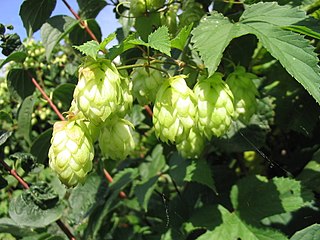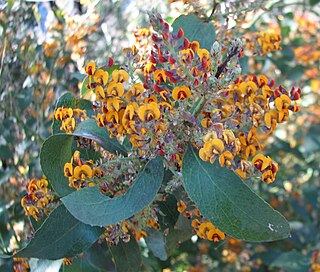
Australian limes are species of the plant genus Citrus that are native to Australia and Papua New Guinea.

Wild rice are four species of grasses forming the genus Zizania, and the grain that can be harvested from them. The grain was historically gathered and eaten in North America, India and China. While now a delicacy in North America, the grain is eaten less in China, where the plant's stem is used as a vegetable.

A wildflower is a flower that grows in the wild, meaning it was not intentionally seeded or planted. Yet "wildflower" meadows of a few mixed species are sold in seed packets. The term implies that the plant probably is neither a hybrid nor a selected cultivar that is in any way different from the way it appears in the wild as a native plant, even if it is growing where it would not naturally. The term can refer to the flowering plant as a whole, even when not in bloom, and not just the flower.

Ostrya is a genus of eight to 10 small deciduous trees belonging to the birch family Betulaceae. Common names include hop-hornbeam and hophornbeam. It may also be called ironwood, a name shared with a number of other plants.

Myrica gale is a species of flowering plant in the genus Myrica, native to northern and western Europe and parts of northern North America. Common names include bog-myrtle sweet willow, Dutch myrtle, and sweetgale. It is a deciduous shrub growing to 1–2 m tall. The leaves are spirally arranged, simple, 2–5 cm long, oblanceolate with a tapered base and broader tip, and a crinkled or finely toothed margin. The flowers are catkins, with male and female catkins on separate plants (dioecious). The fruit is a small drupe.

Humulus lupulus is a species of flowering plant in the hemp family (Cannabaceae), native to Europe, western Asia and North America. It is a dioecious, perennial, herbaceous climbing plant which sends up new shoots in early spring and dies back to a cold-hardy rhizome in autumn.
The Container Revolution is the introduction of pottery into the Eastern Woodlands of North America during the Archaic period. As these societies became more sedentary, they were able to manufacture and use vessels that would have broken during transportation. Pots allowed for more efficient processing of wild seeds, which created less work for people when the pots were made waterproof. More-efficient seed collection systems and the deliberate manipulation of the native plants, in turn led to the domestication of several plant species. This is just one of many cultural developments that began during this time.

The Eastern Agricultural Complex was one of about 10 independent centers of plant domestication in the pre-historic world. By about 1,800 BCE the Native Americans of North America were cultivating for food several species of plants, thus transitioning from a hunter-gatherer economy to agriculture. After 200 BCE when maize from Mexico was introduced to what is now the eastern United States, the Native Americans of the present-day United States and Canada slowly changed from growing local indigenous plants to a maize-based agricultural economy. The cultivation of local indigenous plants other than squash, declined and was eventually abandoned. The formerly domesticated plants, except for squash, returned to their wild forms.

Natural landscaping, also called native gardening, is the use of native plants, including trees, shrubs, groundcover, and grasses which are indigenous to the geographic area of the garden.

Humulus japonicus, known as wild hop or Japanese hop, synonym H. scandens, is an ornamental plant in the Cannabaceae family. Originally found in temperate parts of Asia and the tropical environment of Vietnam, it was imported to North America in the 1800s for use in an Asian tonic and as an ornamental plant. Since its arrival in North America, it has spread widely. It can be found throughout the Northeastern U.S. and eastern Canada. It is considered an invasive species in North America. The composition and chemistry of its oils differ from those of its relative the common hop, Humulus lupulus. As a result, the Japanese hop is not used in the production of beer.

Monarda fistulosa, the wild bergamot or bee balm, is a wildflower in the mint family (Lamiaceae) widespread and abundant as a native plant in much of North America. This plant, with showy summer-blooming pink to lavender flowers, is often used as a honey plant, medicinal plant, and garden ornamental. The species is quite variable, and several subspecies or varieties have been recognized within it.
Wild leek is a common name for several plants in the genus Allium

Blueberries are perennial flowering plants with blue– or purple–colored berries. They are classified in the section Cyanococcus within the genus Vaccinium. Vaccinium also includes cranberries, bilberries, and huckleberries. Commercial "blueberries" – including both wild ('lowbush') and cultivated ('highbush') blueberries – are all native to North America. The highbush blueberry varieties were introduced into Europe during the 1930s.
A horticultural flora, also known as a garden flora, is a plant identification aid structured in the same way as a native plants flora. It serves the same purpose: to facilitate plant identification; however, it only includes plants that are under cultivation as ornamental plants growing within the prescribed climate zone or region. Traditionally published in book form, often in several volumes, such floras are increasingly likely to be produced as websites or CD ROMs.

Native trees in Toronto are trees that are naturally growing in Toronto and were not later introduced by humans. The area that presently comprise Toronto is a part of the Carolinian forest, although agricultural and urban developments destroyed significant portions of that life zone. In addition, many of Toronto's native trees have been displaced by non-native plants and trees introduced by settlers from Europe and Asia from the 18th century to the present. Most of the native trees are found in the Toronto ravine system, parks, and along the Toronto waterway system.

The Sylvania Mountains Wilderness is a federally designated wilderness area located 30 miles (48 km) east of Bishop in the state of California. The wilderness is 18,677acres in size and is managed by the Bureau of Land Management (BLM). The California Desert Protection Act of 1994 created the Sylvania Mountains Wilderness and was added to the National Wilderness Preservation System. The wilderness is bordered by Nevada stateline on the east, Piper Mountain Wilderness on the west and Death Valley National Park to the south.

Bryonia alba is a vigorous vine in the family Cucurbitaceae from Europe and Northern Iran. It has a growth habit similar to kudzu, which gives it a highly destructive potential outside its native range as a noxious weed. Other common names include false mandrake, English mandrake, wild vine, and wild hops, wild nep, tamus, ladies' seal, and tetterbury.

Daviesia latifolia, commonly known as hop bitter-pea, is a shrub in the family Fabaceae. It usually grows to between 1 and 3 metres high and has large leaves with a prominent network of veins. Clusters of yellow and brown pea flowers are produced between September and December in the species native range. The species was first formally described by botanist Robert Brown, his description published in Hortus Kewensis in 1811. It is endemic to eastern Australia.
















